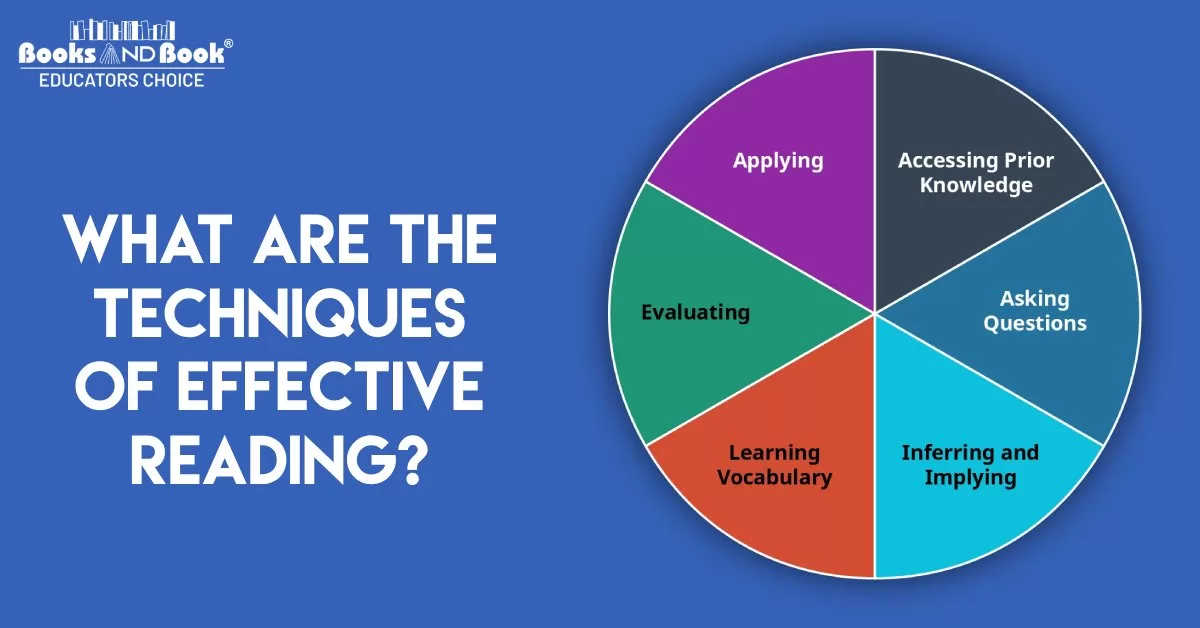Reading is a critical skill for academic and professional success. Developing strong and comprehensive reading comprehension strategies can vastly improve reading effectiveness and get more out of texts.
But, many passionate readers question, “What are the techniques of effective reading?”
This article outlines methods for improving reading comprehension across formats through techniques like skimming, scanning, annotation, visualization, SQ3R, and more.
By actively applying these multifaceted approaches to better reading comprehension, students and professionals alike can enhance learning and research.
What are The Techniques of Effective Reading?
1. Skimming and Scanning
Strategies for effective reading techniques include targeted skimming and scanning approaches. Employing these skills equips readers to gather information efficiently.
Skimming
Skimming involves quickly going through a text to grasp the main ideas and key points without reading every word. The purpose of skimming is to gain a high-level overview of a reading selection or book chapter so you can evaluate relevance or decide which sections to focus on.
To skim effectively, move your eyes quickly over the text and focus on headings, the introductory and concluding paragraphs, the topic sentence of each paragraph, bolded or italicized words, bullet points, captions, and any graphics.
Absorb the main thrust without getting bogged down in details. This selective reading provides a broad conceptual understanding to orient further reading.
Scanning
Scanning is a reading technique that helps locate specific details and facts within a text without having to read the whole passage. Scanning involves strategically searching for a particular word, phrase, date, name, statistic, or other specific piece of information.
This allows efficient retrieval of details needed to answer questions, support arguments, build knowledge on a subject, or complete assignments.
To scan well, first define the precise information needed and potential keywords related to it. Then quickly move eyes over subheadings, first sentences of paragraphs, emphasized text, captions, tables, or charts to hunt for the target data.
Once located, read surrounding sentences to put details into context. Scanning prepared texts, articles, or books can rapidly provide granular information gathering.
2. Active Reading
Active reading strategies entail engaging critically with texts using approaches like annotation, questioning, and summarization. Mastering these effective methods for comprehensive reading fosters deeper comprehension, retention, and learning.
Annotation
Annotating while reading texts is a vital skill for active reading comprehension. Marking up passages encourages engagement with the material, solidifies understanding, enables easier review of key information, and plants seeds for insightful questions.
The significance of annotation is the way it stimulates analysis and evaluation during the initial reading process. Readers can highlight major themes, underline key definitions, circle confusing terms, jot quick clarifying notes in the margins, bracket pivotal passages, and identify striking quotes worth revisiting.
Effective annotation techniques involve using different colors to categorize types of annotations, keeping notes brief but clear, numbering pages for quick references, being selective with markings to highlight the most salient points, and writing summaries at logical breaking points.
Questioning
Constructing incisive questions while reading is another critical reading strategy. Questions guide purpose and priorities, spur interest in content, monitor comprehension, enable elaboration on concepts, and foster critical thinking.
Developing substantive questions takes practice but is one of the fundamental skills for successful reading comprehension.
Questions like “What is the author’s central argument and am I convinced by the supporting evidence?” or “How does this concept connect with or contradict other readings?” or “What implications or applications does this idea have?” stimulate the deeper learning vital for academic and professional reading.
Whether questioning before reading to target focus areas, or during reading to test understanding, or after reading to encourage reflection, sustained questioning engages the reader in conversation with the text and author. This metacognitive dialogue pushes reading from a passive transfer of information to an active meaning-making process.
Summarization
Summarizing key information is also an essential ability. Condensing lengthy or multifaceted readings into accurate and concise synopses cements comprehension while distilling vital concepts.
Executive summaries at logical breaks while reading provide useful mileposts confirming the development of core ideas. Brief memorized capsules of book chapters, research reports, or instruction manuals enable efficient review and fruitful synthesis writing. Distinct components lend themselves to focused summarization like results of a scientific study or key revelations in an investigative article.
Techniques for concise and effective summarization include:
- Synthesizing central themes
- Articulating how details relate to main ideas
- Capturing turning points in arguments
- Defining unfamiliar concepts
- Outlining chronological progression
- Memorializing impactful quotes
Continual summarization while reading improves attention, understanding, recall, and work with the material after.
3. Mind Mapping
Mind mapping is a multifaceted reading technique that utilizes visual diagrams to organize and connect ideas, boosting comprehension and recall.
A mind map is a graphical representation used to structure information in a visual format surrounding a central concept or theme. The core topic branches into major supporting subtopics, which further branch into specifics and details represented as a radiating hierarchy. Relationships can be indicated with arrows, groupings, colors, icons, and organizational divisions.
Creating mind maps while reading or reviewing information provides valuable benefits:
- Encourages active processing of content into hierarchical categories
- Engages visual and spatial cognitions to solidify memory
- Illustrates connections between concepts clearly
- Enables grasping complexity as mapped models
- Fosters creativity and individualized understanding
Applying Mind Mapping Techniques
To utilize mind mapping for more effective reading comprehension:
- Identify the central focus or thesis statement to become the core topic
- Note major supporting arguments, themes, or findings as first-level branches
- Outline evidence, specifics, and elaborations as sub-branches
- Use symbols, colors, and groupings to indicate relationships
- Craft a personalized landscape visually organizing information
- Review the mind map to strengthen retention and analysis
With some practice, mind mapping from readings becomes an engaging multimedia experience that drives deeper learning. Diagramming what you read cements comprehension, fuels insights, and provides unique visual study aids.
4. SQ3R Method
The SQ3R technique provides a structured active reading comprehension process that builds strong reading strategies through five steps: Survey, Question, Read, Recite and record, and Review. Practicing this approach is one of the best ways to develop efficient reading skills.
Step-By-Step Process
Here is an overview of the five steps:
Survey – Scan the text features including headings, subheadings, topic sentences, bolded terms, summaries, and any figures. This superficial survey establishes scope and direction.
Question – Based on the initial survey, generate questions to guide focused reading. Turn section headers into questions. Define what to look for.
Read – Read the selection closely while consciously trying to answer the questions raised. Seek well-rounded comprehension centered around the self-created framework.
Recite & Record – Verbalize, outline, or draft brief notes capturing main ideas and key supporting points. Articulate concisely in your own words.
Review – Look over notes, revisit underlined passages, test yourself on the questions formulated earlier, and connect back to initial impressions from the survey phase. Review cements long-term retention.
Benefits of SQ3R
Applying the SQ3R system assists depth and efficiency of reading comprehension through:
- Forcing engagement before, during, and after reading
- Prioritizing focused areas for attention
- Promoting concise processing of concepts
- Building connections between ideas
- Enabling self-testing for confidence
Committing to this active reading approach yields dividends in learning capabilities that transfer widely. Internalizing SQ3R reading strategies can evolve reading abilities dramatically.
Prioritizing Reading Material
Students and professionals often need to digest a high volume of reading across multiple subjects or responsibility areas. Effectively managing workload requires thoughtful prioritization and time allocation strategies. This section provides constructive tips for determining reading priorities and organizing schedules to become a more efficient reader.
Tips for Prioritizing Reading Materials
When facing many reading assignments or selections:
Identify purpose – Skim through introductions and summaries to determine usefulness and relevance.
Assess difficulty – Gauge which selections are most complex or unfamiliar to tackle first.
Evaluate length – Consider piece length in prioritizing; sequence shorter readings as palate cleansers.
Determine importance – Note any cues from instructors or managers regarding expectations and significance.
Categorize subject matter – Rank items focused on key subjects higher than peripheral or redundant materials.
Time Management Strategies for Efficient Reading
Once prioritized, optimize reading time by
- Blocking time daily for reading high-priority items free from distraction.
- Previewing selections beforehand to formulate focus questions.
- Collecting & organizing relevant texts to eliminate hunts.
- Taking summary notes for retention and review.
- Completing associated tasks like margin annotations or vocabulary lookups.
- Cueing memory with visual bookmarks, notes, or mindmaps.
- Monitoring pace and concentration to self-adjust as needed.
While demands often feel overwhelming, following focused strategies to tackle the most critical readings first and scheduling consistent reading blocks makes conquering the queue very doable. Employing these tips will evolve reading abilities while keeping overwhelmed at bay as the to-do list gets efficiently untangled.
Active Engagement with Text
A common challenge when reading is maintaining focus and connecting with the material. Without engagement, comprehension and retention suffer. Utilizing deliberate tips for mastering effective basic reading skills can dramatically boost understanding.
Below are strategies to spark ongoing engagement and forge meaningful connections as you read.
Strategies for Staying Engaged While Reading
Active reading requires concerted attention and interaction. To stay engaged:
- Formulate questions before starting to read to define the focus
- Annotate passages by underlining key points and making brief marginal notes
- Periodically summarize or explain sections out loud in your own words
- Visualize descriptions, characters, or processes depicted
- Consciously relate concepts back to central arguments or themes
- Monitor if the mind wanders and purposefully refocus
Applying these techniques for successful reading comprehension through the process sustains the investment required for high-caliber learning.
Connecting With the Material
Constructing personalized connections multiplies insights extracted:
- Identify relatable situations or examples from your own life
- Synthesize by linking reading to previous knowledge
- Apply ideas by considering implications or usages
- Analyze unique perspectives found inspiring
- Relate surprising discoveries that force reevaluation
- Evaluate the validity of assertions through logical reasoning
Leveraging these aspects of critical analysis, conceptual bridging, and participative meaning-making instead of passive reading fosters genuine understanding and command of the knowledge gleaned.
Conclusion
Reading serves as a gateway for absorbing information that fuels knowledge work across all disciplines. However, with overflowing access exploding in the digital age, what are the techniques of effective reading for reliably uplifting comprehension?
The techniques for effective reading explored in this article, such as annotative questioning, strategic skimming, and scanning, mind mapping core concepts, applying structured frameworks like SQ3R, and carving out prioritized reading time, offer tangible mechanisms for enhancing that dialogue.
Investing to actively strengthen such multidimensional reading comprehension methodologies pays dividends in accelerated learning, boosting information retention and synthesis while cultivating deeper analysis.
As reading demands rise across academic and professional contexts, fortifying the skills for engaged reading equips any leader, student, or career professional to extract maximum value from these precious resources.
FAQ’s
How can I improve my reading comprehension?
Actively engage with the text by asking questions and making connections to enhance your understanding.
Is it beneficial to set a purpose before reading?
Absolutely, setting a clear purpose helps focus your reading and improves overall comprehension.
How can I overcome subvocalization and increase reading speed?
Practice silent reading and gradually increase your pace, using techniques like pacing to overcome subvocalization.
What role does previewing play in effective reading?
Previewing allows you to grasp the main ideas and structure of the text before diving into a detailed read, aiding comprehension.
Can summarizing help with information retention?
Yes, summarizing key points after each section reinforces understanding and retention of the material.


